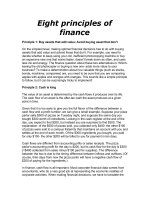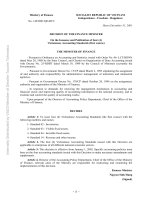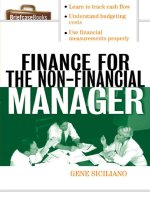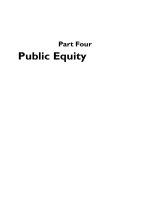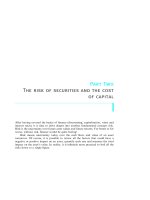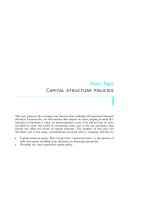QUAINTITATWE FINANCE RISK MANAGEMNET pdf
Bạn đang xem bản rút gọn của tài liệu. Xem và tải ngay bản đầy đủ của tài liệu tại đây (30.36 MB, 802 trang )
QUINTITATWE
FINANCE
RISK
MANAGEMENT
AND
-
&
-
A Physicist’s Approach
This page intentionally left blank
ITATIVE
FINANCE
AND
MANAGEMENT
A Physicist’s Approach
Jan
W
Dash
\k
World
Scientific
NEW JERSEY
LONDON
*
SINGAPORE
*
BElJlNG
*
SHANGHAI
*
HONG KONG TAIPEI CHENNAI
Published by
World Scientific Publishing Co. Re. Ltd.
5
Toh Tuck Link, Singapore
596224
USA
ofice:
Suite
202,
1060
Main Street, River Edge,
NJ
07661
UK
ofice:
57
Shelton Street, Covent Garden, London
WC2H 9HE
British Library Cataloguing-in-Publication Data
A catalogue record
for
this
book
is available from the British Library.
QUANTITATIVE FINANCE
AND
RISK
MANAGEMENT
A Physicist’s Approach
Copyright
0
2004
by World Scientific Publishing
Co.
Pte. Ltd.
All
rights reserved. This book, or parts thereof, may not be reproduced in any form or
by
any means,
electronic or mechanical, including photocopying, recording or any information storage and retrieval
system now known or to be invented, without written permission from the Publisher.
For
photocopying
of
material in this volume, please pay a copying fee through the Copyright
Clearance Center, Inc.,
222
Rosewood Drive, Danvers, MA
01923,
USA. In this case permission to
photocopy is not required
from
the publisher.
ISBN
981-238-712-9
This book is printed on acid-free paper.
Printed in Singapore by Mainland
Press
Dedication
I
dedicate this book to my father and mother, Edward and Honore Dash. They
inspired learning and curiosity, and advised never to take anything for granted.
This page intentionally left blank
Table
of
Contents
ACKNOWLEDGEMENTS
xix
PART
I:
INTRODUCTION.
OVERVIEW.
AND
EXERCISE
1
1 . Introduction and Outline
3
Who/ Howmat, “Tech
.
Index”, Messages, Personal Note
3
Summary Outline: Book Contents
5
Overview (Tech . Index 1/10)
7
Objectives
of
Quantitative Finance and Risk Management
7
Tools
of
Quantitative Finance and Risk Management
9
The Traditional Areas of Risk Management
11
When Will We Ever See Real-Time Color Movies of Risk?
13
Quants in Quantitative Finance and Risk Management
15
References
17
2
.
Many People Participate in Risk Management
13
3 .
An Exercise (Tech . Index
1/10)
19
Part #1: Data. Statistics. and Reporting Using a Spreadsheet
19
Part #2: Repeat Part #1 Using Programming
22
Part #3: A Few Quick and Tricky Hypothetical Questions
23
Messages and Advice
24
References
24
PART
II:
RISK
LAB (NUTS AND BOLTS
OF
RISK
MANAGEMENT)
25
Equity Options (Tech . Index 3/10)
27
4 .
Pricing and Hedging One Option
27
American Options
30
Basket Options and Index Options
31
Other Types of Equity Options; Exotics
33
Portfolio
Risk
(Introduction)
33
Scenario Analysis (Introduction)
33
References
34
vii
viii
Quantitative Finance and
Risk
Management
5
.
FX
Options (Tech
.
Index 4/10)
35
FX
Forwards and Options
35
Some Practical Details for
FX
Options
38
Hedging
FX
Options with Greeks: Details and Ambiguities
39
FX
Volatility Skew and/or Smile
41
Pricing Barrier Options with Skew
45
Double Barrier Option: Practical Example
47
The “Two-Country Paradox”
48
Quanto Options and Correlations
50
FX
Options in the presence of Stochastic Interest Rates
51
Numerical Codes, Closed Form Sanity Checks, and Intuition
51
References
52
6
.
Equity Volatility Skew (Tech
.
Index 6/10)
53
Put-Call Parity: Theory and Violations
54
The Volatility Surface
55
Dealing with Skew
55
Perturbative Skew and Barrier Options
56
Static Replication
58
Stochastic Volatility
60
Local Volatility and Skew
62
The Skew-Implied Probability Distribution
63
Local vs
.
Implied Volatility Skew; Derman’s Rules of Thumb
63
Intuitive Models and Different Volatility Regimes
68
Jump Diffusion Processes
69
Appendix A: Algorithm for “Perturbative Skew” Approach
69
Option Replication with Gadgets
65
The Macro-Micro Model and Equity Volatility Regimes
69
Appendix B: A Technical Issue for Stochastic Volatility
71
References
72
7
.
Forward Curves (Tech
.
Index 4/10)
73
Market Input Rates
73
Construction of the Forward-Rate Curve
76
References
83
8
.
Interest-Rate Swaps (Tech
.
Index 3/10)
85
Swaps: Pricing and
Risk
85
Interest Rate Swaps: Pricing and Risk Details
91
Counterparty Credit
Risk
and Swaps
107
References
109
9
.
Bonds: An Overview (Tech
.
Index 2/10)
111
Types of Bonds
111
Bond Issuance
115
Table
of
Contents
ix
Bond Trading
116
Bond Math
118
References
121
10
.
Interest-Rate Caps (Tech
.
Index 4/10)
123
Introduction to Caps
123
The Black Caplet Formula
125
Non-USD Caps
127
Relations between Caps. Floors. and Swaps
127
Hedging Delta and Gamma for Libor Caps
128
Hedging Volatility and Vega Ladders
129
Prime Caps and a Vega Trap
131
References
136
Matrices
of
Cap Prices
131
CMT Rates and Volatility Dependence of CMT Products
132
11
.
Interest-Rate Swaptions (Tech
.
Index 5/10)
137
European Swaptions
~
137
Delta and Vega Risk: Move Inputs or Forwards?
143
Swaptions and Corporate Liability Risk Management
144
Practical Example: A Deal Involving a Swaption
146
BermuddAmerican Swaption Pricing
141
Miscellaneous Swaption Topics
148
References
150
12
.
Portfolios and Scenarios (Tech
.
Index 3/10)
151
Introduction
to
Portfolio Risk Using Scenario Analysis
1.51
Definitions of Portfolios
151
Definitions of Scenarios
153
Many Portfolios and Scenarios
155
A Scenario Simulator
157
Risk Analyses and Presentations
157
PART
Ill:
EXOTICS. DEALS. AND CASE
STUDIES
159
13
.
A Complex CVR Option (Tech
.
Index 5/ 10)
161
CVR Starting Point: A Put Spread
162
A Simplified CVR: Two Put Spreads with Extension Logic
165
The
M&A
Scenario
161
CVR Extension Options and Other Complications
162
The Arbs and the Mispricing of the CVR Option
164
Non- Academic Corporate Decision for Option Extension
167
The CVR Option Pricing
169
Analytic CVR Pricing Methodology
173
X
Quantitative Finance and Risk Management
Some Practical Aspects of CVR Pricing and Hedging 176
The CVR Buyback
180
A Legal Event Related to the CVR
180
References
180
14
.
Two More Case Studies (Tech . Index
5/10)
183
D123
:
The Complex DEC Synthetic Convertible
188
Case Study: DECS and Synthetic Convertibles
183
Case Study: Equity Call with Variable Strike and Expiration
193
References
199
15
.
More Exotics and Risk (Tech
.
Index
5/10)
201
Contingent Caps
201
Digital Options: Pricing and Hedging
205
Historical Simulations and Hedging
207
Yield-Curve Shape and Principle-Component Options
209
Principal-Component Risk Measures (Tilt Delta etc.)
210
Reload Options
214
References
217
Hybrid 2-Dimensional Barrier Options-Examples
211
16
.
A Pot Pourri of Deals (Tech . Index
5/10)
219
TIPS (Treasury Inflation Protected Securities)
219
Municipal Derivatives. Muni Issuance. Derivative Hedging
221
Resettable Options: Cliquets
226
Power Options
230
Path-Dependent Options and Monte Carlo Simulation
231
Periodic Caps
231
ARM Caps
231
Index-Amortizing Swaps
232
A Hypothetical Rep0
+
Options Deal
236
Convertible Issuance Risk
239
Difference Option on an Equity Index and a Basket of Stocks
224
References
241
17
.
Single Barrier Options (Tech
.
Index 6/10) 243
Knock-Out Options
245
The Semi-Group Property including a Barrier
247
Calculating Barrier Options
248
Knock-In Options
249
Complicated Barrier Options and Numerical Techniques
252
A Useful Discrete Barrier Approximation
252
“Potential Theory” for General Sets of Single Barriers
253
Useful Integrals
for
Barrier Options
251
Table
of
Contents
xi
Barrier Options with Time-Dependent Drifts and Volatilities
255
References
256
18
.
Double Barrier Options (Tech
.
Index 7/10)
257
Double Barrier Solution with an Infinite Set of Images
258
Double Barrier Option Pricing
260
Rebates for Double Barrier Options
262
References
263
19
.
Hybrid
2-D
Barrier Options (Tech
.
Index 7/10)
265
Pricing the Barrier 2-Dimension Hybrid Options
267
Useful Integrals for
2D
Barrier Options
268
References
269
20
.
Average-Rate Options (Tech
.
Index 8/10)
271
Arithmetic Average Rate Options
in
General Gaussian Models
272
Results for Average-Rate Options in the MRG Model
276
Simple Harmonic Oscillator Derivation for Average Options
277
Thermodynamic Identity Derivation for Average Options
278
Average Options with Log-Normal Rate Dynamics
278
References
280
PART IV: QUANTITATIVE
RISK
MANAGEMENT
281
Fat Tail Volatility (Tech
.
Index 5/10)
283
Gaussian Behavior and Deviations from Gaussian
283
Outliers and Fat Tails
284
Use of the Equivalent Gaussian Fat-Tail Volatility
287
Practical Considerations for the Fat-Tail Parameters
288
References
294
Correlation Matrix Formalism; the N-Sphere (Tech
.
Index 8/10)
295
The Importance and Difficulty of Correlation Risk
295
One Correlation in Two Dimensions
296
Two Correlations in Three Dimensions; the Azimuthal Angle
297
Correlations in Four Dimensions
300
Correlations in Five and Higher Dimensions
301
Spherical Representation of the Cholesky Decomposition
303
Numerical Considerations for the N-Sphere
304
References
305
Stressed Correlations and Random Matrices (Tech
.
Index 5/10)
307
Correlation Stress Scenarios Using Data
307
21
22
23
xii
Quantitative Finance
and
Risk Management
Stressed Random Correlation Matrices
313
Random Correlation Matrices Using Historical Data
313
Stochastic Correlation Matrices Using the W-sphere
314
24
.
Optimally Stressed PD Correlation Matrices (Tech
.
Index 7/10)
319
Least-Squares Fitting for the Optimal PD Stressed Matrix
321
Numerical Considerations
for
Optimal PD Stressed Matrix
322
Example of Optimal PD Fit to a NPD Stressed Matrix
323
SVD Algorithm for the Starting PD Correlation Matrix
325
PD Stressed Correlations by Wallung through the Matrix
328
References
328
25
.
Models for Correlation Dynamics. Uncertainties
(Tech
.
Index 6/10)
329
“Just Make the Correlations
Zero”
Model; Three Versions
329
The Macro-Micro Model for Quasi-Random Correlations
331
Implied. Current. and Historical Correlations for Baskets
338
Plain-Vanilla VAR (Tech
.
Index 4/10)
341
Quadratic Plain-Vanilla VAR and CVARs
344
Monte-Carlo VAR
346
Backtesting
347
Monte-Carlo CVARs and the CVAR Volatility
347
Confidence Levels
for
Individual Variables
in
VAR
350
Correlation Dependence on Volatility
335
26
.
References
351
27
.
ImprovedEnhancedKtressed
VAR (Tech
.
Index 5/10)
353
Improved Plain-Vanilla VAR
(IPV-VAR)
353
EnhancedStressed VAR
(ES-VAR)
357
Other VAR Topics
365
References
368
28
.
VAR. CVAR. CVAR Volatility Formalism (Tech
.
Index 7/10)
369
Set-up and Overview of the Formal VAR Results
369
Calculation
of
the Generating Function
371
VAR, the CVARs, and the CVAR Volatilities
374
Effective Number of SD
for
Underlying Variables
376
Extension to Multiple Time Steps using Path Integrals
378
29
.
VAR and CVAR for Two Variables (Tech
.
Index 5/10)
381
Geometry
for
Risk Ellipse. VAR Line. CVAR. CVAR Vol
382
The CVAR Volatility with Two Variables
381
Table
of
Contents
xiii
30
.
Corporate-Level VAR (Tech
.
Index 3/10)
387
Desk CVARs and Correlations between Desk Risks
389
Aggregation. Desks. and Business Units
387
Aged Inventory and Illiquidity
391
31
.
Issuer Credit Risk (Tech
.
Index 5/10)
393
Transition/Default Probability Matrices
394
Calculation
of
Issuer Risk-Generic Case
399
Example of Issuer Credit Risk Calculation
403
Issuer Credit Risk and Market Risk: Separation via Spreads
406
Separating Market and Credit Risk without Double Counting
407
A Unified Credit
+
Market Risk Model
410
References
413
32
.
Model Risk Overview (Tech
.
Index 3/10)
415
Summary of Model Risk
415
Model Risk and Risk Management
416
Time Scales and Models
416
Long-Term Macro Component with Quasi-Random Behavior
417
Liquidity Model Limitations
417
Which Model Should We Use?
418
Model Risk, Model Reserves, and Bid-Offer Spreads
418
Model Quality Assurance
419
Models and Parameters
419
References
420
33
.
Model Quality Assurance (Tech
.
Index 4/10)
421
Model Quality Assurance Goals. Activities. and Procedures
421
Model QA: Sample Documentation
424
User Section of Model QA Documentation
425
Quantitative Section of Model QA Documentation
425
Systems Section of Model QA Documentation
428
References
430
34
.
Systems Issues Overview (Tech
.
Index 2/10)
431
Advice and a Message to Non-Technical Managers
431
What are Some Systems Traps and Risks?
432
.
What are the “Three-Fives Systems Criteria”?
431
What is the Fundamental Theorem
of
Systems?
432
The Birth and Development of a System
433
Systems in Mergers and Startups
435
Vendor Systems
436
New Paradigms in Systems and Parallel Processing
437
Languages for Models: Fortran
90,
C++, C, and Others
438
What‘s the “Systems Solution”?
440
xiv
Quantitative Finance and Risk Management
Are Software Development Problems Unique to Wall Street?
440
References
440
35
.
Strategic Computing (Tech
.
Index 3/10)
441
Introduction and Background
442
Illustration of Parallel Processing for Finance
442
Some Aspects of Parallel Processing
443
Technology, Strategy and Change
446
References
447
36
.
Qualitative Overview of Data Issues (Tech
.
Index 2/10)
449
Data Consistency
449
Data Reliability
450
Data Vendors
450
Data Completeness
450
Historical Data Problems and Data Groups
451
Preparation of the Data
451
Bad Data Points and Other Data Traps
451
37
.
Correlations and Data (Tech
.
Index 5/10)
453
Fluctuations and Uncertainties
in
Measured Correlations
453
Time Windowing
454
Correlations, the Number of Data Points, and Variables
456
Intrinsic and Windowing Uncertainties: Example
458
Two Miscellaneous Aspects of Data and Correlations
460
References
460
38
.
Wishart’s Theorem and Fisher’s Transform (Tech
.
Index 9/10)
461
The Wishart Distribution
464
The Probability Function for One Estimated Correlation
465
Fisher’s Transform and the Correlation Probability Function
466
The Wishart Distribution Using Fourier Transforms
468
Warm Up: The Distribution for a Volatility Estimate
462
References
473
39
.
Economic Capital (Tech
.
Index 4/10)
475
Basic Idea of Economic Capital
475
Exposures for Economic Capital: What Should They Be?
480
Attacks on Economic Capital at High CL
480
The Cost of Economic Capital
483
An Economic-Capital Utility Function
484
Sharpe Ratios
484
The Classification of Risk Components of Economic Capital
479
Allocation: Standalone, CVAR,
or
Other?
481
Revisiting Expected Losses; the Importance of Time Scales
485
Table
of
Contents
XV
Cost Cutting and Economic Capital
487
Traditional Measures of Capital. Sharpe Ratios. Allocation
487
References
488
40
.
Unused-Limit Rsk (Tech
.
Index 6/10)
489
General Aspects
of
Risk Limits
489
The Unused Limit Risk Model: Overview
491
Unused Limit Economic Capital for Issuer Credit Risk
497
PART
V:
PATH INTEGRALS. GREEN FUNCTIONS.
AND OPTIONS
499
41
.
Path Integrals and Options: Overview (Tech
.
Index 4/10)
501
42
.
Path Integrals and Options
I:
Introduction (Tech
.
Index 7/10)
505
Introduction to Path Integrals
506
Path-Integral Warm-up: The Black Scholes Model
509
Connection of Path Integral with the Stochastic Equations
521
Dividends and Jumps with Path Integrals
523
Discrete Bermuda Options
530
American Options
537
Appendix A: Girsanov’s Theorem and Path Integrals
538
Appendix C: Perturbation Theory, Local Volatility, Skew
546
References
556
Appendix B: No-Arbitrage, Hedging and Path Integrals
541
Figure Captions for this Chapter
546
43
.
Path Integrals and Options 11: Interest-Rates (Tech
.
Index 8/10)
559
I
.
Path Integrals: Review
561
I1
.
The Green Function; Discretized Gaussian Models
562
I11
.
The Continuous-Time Gaussian Limit
566
IV
.
Mean-Reverting Gaussian Models
569
V
.
The Most General Model with Memory
574
VI
.
Wrap-up for this Chapter
578
Appendix B: Rate-Dependent Volatility Models
586
Figure Captions for This Chapter
591
References
594
Appendix A: MRG Formalism, Stochastic Equations, Etc
579
Appendix C: The General Gaussian Model With Memory
589
44
.
Path Integrals and Options 111: Numerical (Tech
.
Index 6/10)
597
Path Integrals and Common Numerical Methods
598
Basic Numerical Procedure using Path Integrals
600
The Castresana-Hogan Path-Integral Discretization
603
xvi
Quantitative Finance and Risk Management
45 .
46 .
Some Numerical Topics Related to Path Integrals
608
A Few Aspects of Numerical Errors
614
Some Miscellaneous Approximation Methods
618
References
624
Path Integrals and Options IV: Multiple Factors
(Tech
.
Index 9/10) 625
Calculating Options with Multidimensional Path Integrals
628
Principal-Component Path Integrals
629
References
630
The Reggeon Field Theory. Fat Tails. Chaos (Tech
. Index lO/lO)
631
Introduction to the Reggeon Field Theory
(RFT)
631
Summary
of the RFT in Physics 632
Aspects of Applications of the
RFT
to Finance
637
References
638
PART
VI:
THE MACRO-MICRO MODEL (A RESEARCH TOPIC)
639
47 .
The Macro-Micro Model: Overview (Tech . Index 4/10)
641
Explicit Time Scales Separating Dynamical Regions
641
I
. The Macro-Micro Yield-Curve Model
642
I1
.
Further Developments in the Macro-Micro Model 646
I11
.
A Function Toolkit
647
References
648
48 . A Multivariate Yield-Curve Lognormal Model (Tech
.
Index 6/10)
.
649
Summary of this Chapter
649
The Problem of JQnks in Yield Curves for Models
650
I
. Introduction to this Chapter
650
IIA
. Statistical Probes. Data. Quasi-Equilibrium Drift
653
IIB
. Yield-Curve Kinks: BCte Noire of Yield Curve Models
655
I11
. EOF
/
Principal Component Analysis
656
IV
. Simpler Lognormal Model with Three Variates 658
V
. Wrap-up and Preview of the Next Chapters
659
Appendix A: Definitions and Stochastic Equations
659
Appendix
B: EOF or Principal-Component Formalism
662
Figures: Multivariate Lognormal Yield-Curve Model
667
References
680
49
.
Strong Mean-Reverting Multifactor YC Model (Tech . Index 7/10) . 681
Summary
of
this Chapter
681
I
.
Introduction to this Chapter
682
I1
.
Cluster Decomposition Analysis and the SMRG Model
685
Table
of
Contents
xvii
I11
.
Other Statistical Tests and the SMRG Model
691
IV
.
Principal Components
(EOF)
and the SMRG Model
694
V
.
Wrap-up for this Chapter
694
Appendix A: Definitions and Stochastic Equations
695
Appendix
B:
The Cluster-Decomposition Analysis (CDA)
697
Figures: Strong Mean-Reverting Multifactor Yield-Curve Model
701
References
715
50
.
The Macro-Micro Yield-Curve Model (Tech
.
Index
5/10)
717
Summary
of
this Chapter
717
I
.
Introduction to this Chapter
718
Prototype: Prime (Macro) and Libor (Macro
+
Micro)
720
I1
.
Details of the Macro-Micro Yield-Curve Model
721
I11
.
Wrap-up of this Chapter
724
Appendix A
.
No Arbitrage and Yield-Curve Dynamics
725
References
730
Figures: Macro-Micro Model
726
51
.
Macro-Micro Model: Further Developments (Tech
.
Index 6/10)
731
Summary of This Chapter
731
The Macro-Micro Model for the
FX
and Equity Markets
733
Macro-Micro-Related Models
in
the Economics Literature
735
Related Models for Interest Rates in the Literature
735
Related Models for
FX
in
the Literature
736
Formal Developments in the Macro-Micro Model
737
No Arbitrage and the Macro-Micro Model: Formal Aspects
739
Hedging, Forward Prices, No Arbitrage, Options (Equities)
741
Satisfying the Interest-Rate Term-Structure Constraints
744
Other Developments in the Macro-Micro Model
745
Derman’s Equity Regimes and the Macro-Micro Model
745
Seigel’s Nonequilibrium Dynamics and the MM Model
745
Macroeconomics and Fat Tails (Currency Crises)
746
Some Remarks on Chaos and the Macro-Micro Model
747
Technical Analysis and the Macro-Micro Model
749
The Macro-Micro Model and Interest-Rate Data 1950-1996
750
Data, Models, and Rate Distribution Histograms
751
Negative Forwards in Multivariate Zero-Rate Simulations
752
References
753
52
.
A Function Toolkit (Tech
.
Index 6/10)
755
Summary
of
Desirable Properties of Toolkit Functions
757
Construction
of
the Toolkit Functions
757
Relation of the Function Toolkit to Other Approaches
762
Example
of
Standard Micro “Noise” Plus Macro “Signal”
764
Time Thresholds; Time and Frequency; Oscillations
756
xviii
Quantitative Finance and
Risk
Management
The Total Macro: Quasi-Random Trends
+
Toolkit Cycles
767
Short-Time Micro Regime. Trading. and the Function Toolkit
768
Appendix: Wavelets. Completeness. and the Function Toolkit
769
References
771
Index
773
Acknowledgements
First,
I
owe
a
big debt of gratitude to Andy Davidson, Santa Federico, and Les
Seigel, all super quants, for their support. The work of two colleagues contributed
to this book: Alan Beilis (who collaborated with me on the Macro-Micro model),
and Juan Castresana (who implemented numerical path-integral discretization).
I
thank them and the other members
of
the quant groups
I
managed over the years
for
their dedication and hard work. Many other colleagues helped and taught me,
including quants, systems people, traders, managers, salespeople, and risk
managers.
I
thank them all. Some specific acknowledgements are in the text.
Rich Lee, extraordinary
FX
systems person killed on
911
1,
is remembered.
I
thank Global Risk Management, Salomon Smith Barney, Citigroup for a
nine-month leave
of
absence during
2002-03
when part of this book was written.
The Centre de Physique ThCorique (CNRS Marseille, France) granted a leave
of absence during my first few years on the Street, for which
I
am grateful.
The editors at World Scientific have been very helpful.
I
especially thank my family for their encouragement, including my daughter
Sarah and son David.
I
could not have done any of this without the constant
understanding and love from my wife Lynn.
xix
This page intentionally left blank
PART
I
INTRODUCTION, OVERVIEW,
AND
EXERCISE
This page intentionally left blank
1.
Introduction and Outline
Who/ HowNhat, “Tech. Index”, Messages, Personal Note
1.
For Whom is This Book Written?
This book is primarily for PhD scientists and engineers who want to learn about
quantitative finance, and for graduate students in finance programs’. Practicing
quantitative analysts (“quants”) and research workers will find topics of interest.
There are even essays with no equations for non-technical managers.
2.
How
Can This Book Benefit You?
This book will enable you to gain an understanding of practical and theoretical
quantitative finance and risk management.
3.
What is
In
This Book?
The book is a combination
of
a
practical “how it’s done” book, a textbook, and a
research book. It contains techniques and results for quantitative problems with
which
I
have dealt in the trenches for over fifteen years as a quant on Wall Street.
Each topic is treated as a unit, sometimes drilling way down. Related topics are
presented parallel, because that is how the real world works. An informal style is
used to convey
a
picture
of
reality. There are even some stories.
4. What is the “Tech. Index”? What Finance Background is Needed?
The “Tech. Index” for each chapter is a relative index for this book lying between
1-10
and indicating mathematical sophistication. The average index is
5.
An
index
1-3
requires almost no math, while
8-10
requires a PhD and maybe more.
No
background in finance is assumed, but some would definitely be helpful.
’
History:
The book is an outgrowth of my tutorial on Risk Management given annually
for five successive years
(1
996-2000)
at the Conference on Intelligence in Financial
Engineering
(CIFEr),
organized jointly by the
IEEE
and
IAFE.
The attendees comprised
roughly
50%
quantitative analysts holding jobs
in
finance and
50%
PhD scientists
or
engineers interested in quantitative finance.
3
4
Quantitative Finance and Risk Management
5.
How
Should
You
Read This
Book?
What is in the Footnotes?
You
can choose topics that interest you. Chapters are self-contained. The
footnotes add depth and commentary; they are useful sidebars.
6.
Message to Non-Technical Managers
Parts of this book will help you get
a
better understanding of quantitative issues.
Important chapters have discussions of systems, models, and data. Skip sections
with equations (or maybe read chapters with the Tech. Index up
to
3).
7.
Message to Students
You
will learn quantitative techniques better if you work through derivations on
your own, including performing calculations, programming and reflection. The
mathematician George Polya gave some good advice: “The best way
to
learn
anything is
to
discover
it
by yourself“. Bon voyage.
8.
Message
to
PhD Scientists and Engineers
While the presentation is aimed at being self-contained, financial products are
extensive. Reading
a
finance textbook in parallel would be
a
good idea.
9.
Message to Professors
Part of the book could be used in
a
PhD finance course (Tech. Index up
to
S),
or
for MBAs (Tech. Index up to
5).
Topics you may find of interest include:
(1)
Feynman path integrals and Green functions for options,
(2)
The Macro-Micro
model with explicit time scales connecting to both macroeconomics and finance,
(3)
Optimally stressed correlation matrices,
(4)
EnhancedStressed VAR.
10.
A
Personal Note
This book
is
largely based on my own work and/or first-hand experience. It is in
part retrospective, looking back over trails traversed and sometimes blazed. Some
results are in
1988-89
CNRS preprints when
I
was
on leave from the CNRS
as
the head of the Quantitative Analysis Group at Merrill Lynch, in my
1993
SIAM
Conference talk, and in my CIFEr tutorials. Footnotes entitled “History” contain
dates when my calculations were done over the years, along with recollections2.
’
History: To translate
dates,
my
positions were VP Manager
at
Merrill Lynch
(1
987-89);
Director
at
Eurobrokers
(1
989-90), Director
at
Fuji
Capital
Markets
Corp.
(1
990-93),
VP
at
Citibank
(1
993),
and
Director
at
Smith Barney/Salomon Smith Barney/Citigroup
(1993-2003).
I
managed PhD Quantitative Analysis Groups at Merrill, FCMC,
and
at
SB/SSB/Citigroup
through
various
mergers.

